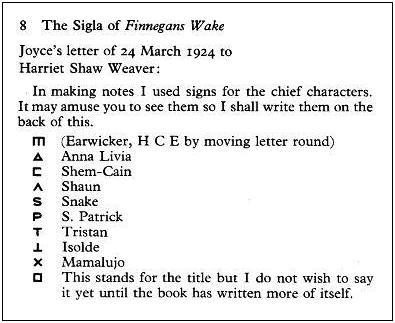Page-a-day page-pages look like this:
"Assigned reading" links the Fweet page-of-the-day with the text, plus interlinear notes (see below). The little "[]" link is to the web edition of FW at trentu.ca, with old-style line-numbers. "[secondary]" links to an alternative Web collation of notes, without the interlinear text, and with a lot of extra suggestions that can get wild. "[McH]" links page-images of Roland McHugh's Annotations to FW, the godfather of all these efforts, now dated.
"FDV:" links David Hayman's classic First-Draft Version of FW, followed by an extract of just the deepest layer. At the bottom of each page-page you should find a little mp3-player tuned to the lickety-split 17-CD FW reading by Patrick Healy.
[Tindall]
The Fweet links are complicated (and getting comfortable with them will be a shorter-term goal), so before we start with page 3, I want to address more general questions.
The text itself is on the mustard-colored lines, with the standard page and line numbers at the start of each line. Fweet offers a font for displaying Joyce's 'sigla', but it only works if you let webpages choose their own fonts.
At the top and bottom of the Fweet pages there are links to both the Next and Previous pages. Because the Wake is a circle, the Previous page is page 628. (If we do a page a day, it should take about two years.)
There's a "Comment on Me!!" link at the bottom of the Fweet screen that you can use to suggest additions, but I'd recommend you post them here instead to make things easier for Rafael.
Here's an Online Shorter FW. And a listing of the changes in the new "Restored" edition (FW2): http://fweet.org/pages/fw_rest.php
If you want an ebook, I recommend the FW2. [Amazon-UK] If you want something printed, avoid the Penguin with the introduction by Bishop-- it's got the worst typos and bad printing. Any other edition you can pick up secondhand will be a better value. This one looks great. (It's nice to mark your progress with lots of underlining and marginalia.) [Amazon] [pdf]
Historical maps of Dublin
It's agreed that Joyce intended the language to be conventionally grammatical, with subjects, verbs, and objects that obey the classic rules. Sometimes it takes a lot of digging to fit the clues together.
All language has rhythm, but sometimes it's hard to tell what rhythm Joyce intended. It's always meant to express the themes of the passage, often by echoing the rhythms of other literature or song. There are lots of places where Joyce's preferred pronunciation is uncertain, with very weird Gaelic spellings especially tricky. The rhythmic echoes can be so subtle they take years to unpack.
All existing theories of what Joyce was doing and what FW is 'about' are wrong.



Highly recommend finnegansweb too, a Finnegans Wake Wiki:
ReplyDeletehttp://finnegansweb.com/wiki/index.php/Main_Page
Maye I'm doing it wrong, but it seems to take an awful lot of clicking, even to confirm there's nothing new for any given phrase...? Are you willing to repost any and all new insights here, too?
DeleteCould you make it so hovering over a phrase lets you see all the notes, in a floating textbox?
Delete